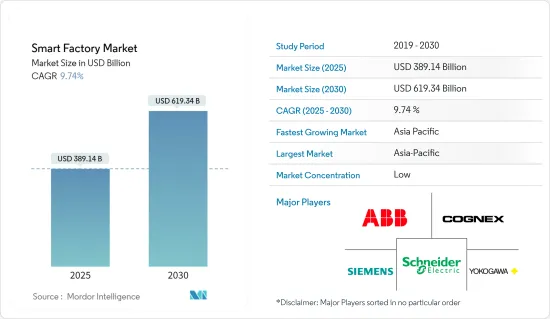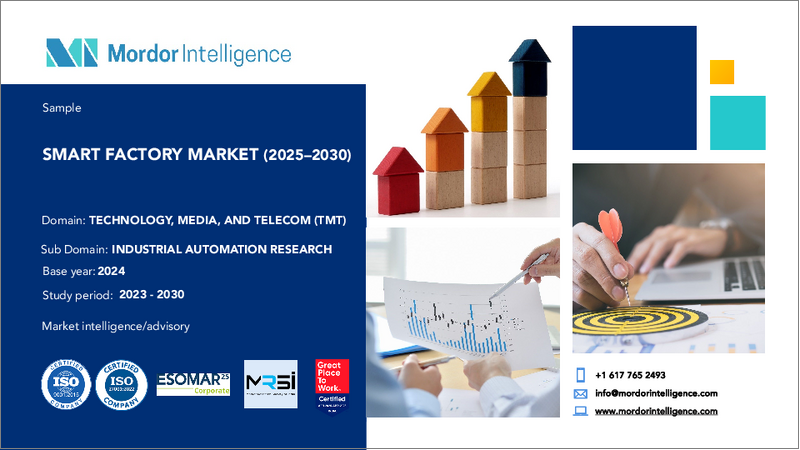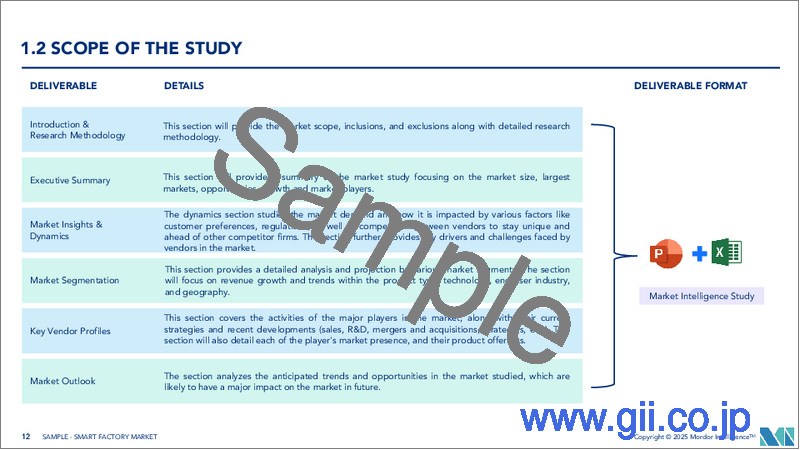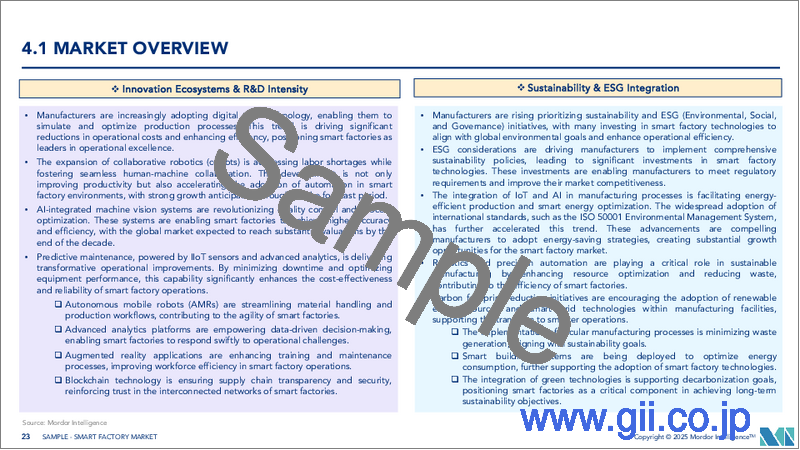|
|
市場調査レポート
商品コード
1686593
スマートファクトリー:市場シェア分析、産業動向・統計、成長予測(2025~2030年)Smart Factory - Market Share Analysis, Industry Trends & Statistics, Growth Forecasts (2025 - 2030) |
||||||
カスタマイズ可能
適宜更新あり
|
|||||||
| スマートファクトリー:市場シェア分析、産業動向・統計、成長予測(2025~2030年) |
|
出版日: 2025年03月18日
発行: Mordor Intelligence
ページ情報: 英文 120 Pages
納期: 2~3営業日
|
全表示
- 概要
- 目次
スマートファクトリーの市場規模は2025年に3,891億4,000万米ドルと推定され、予測期間(2025~2030年)のCAGRは9.74%で、2030年には6,193億4,000万米ドルに達すると予測されます。

主なハイライト
- インダストリー4.0とIoTの承認による製造業の大幅なシフトにより、企業は、人間労働を自動化で補完・拡張し、プロセスの失敗による産業事故を削減する技術で生産を前進させるために、機敏でより革新的かつ創造的な方法を採用する必要があります。接続されたデバイスやセンサーの採用率が高まり、M2M通信が促進されるにつれて、製造業で開発されるデータポイントの急増が見られます。
- ZebraのManufacturing Vision Studyによると、IoTとRFIDに基づくスマート資産追跡ソリューションは、2022年に従来のスプレッドシートベースの方法を追い抜きました。Maryville Universityの計算によると、2025年までに世界中で年間180兆ギガバイト以上のデータが作成されると予想されています。IIoT対応産業はこの大部分を生み出すと思われます。また、産業用IoT(IIoT)企業であるMicrosoft Corporationの調査によると、企業の85%が少なくとも1つのIIoTユースケースプロジェクトを抱えていることがわかりました。2022年には回答者の約95%がIIoT戦略を実施するため、この数字は増加しました。
- 製造施設の持続的な開発増加と相まって、技術の進歩は予測期間中の市場成長率に影響を与えると予想されます。例えば、Intelは最近、Telecom ItaliaおよびハードウェアメーカーのExor Internationalと提携し、人工知能(AI)と5Gネットワーキングを利用したスマート製造施設を開発しました。
- さらに、AIと機械学習(ML)技術の市場浸透が加速することで、データ分析の精度とスピードが向上し、それによって市場が大きく前進する可能性があります。さらに、フィールドデバイス市場、ロボット、センサーの進歩は、市場の範囲をさらに拡大する可能性があります。Ciscoの予測によると、2022年までに、IoTアプリケーションをサポートするマシンツーマシン(M2M)接続は、世界の285億接続デバイスの50%以上を占める可能性があります。多くの政府も、スマートファクトリー導入のためにIoT技術に投資するよう製造企業に働きかけています。
- しかし、高い設置コストが市場成長の課題となっています。さらに、自動化インフラを運用・維持するために高度なスキルを持つ労働力が必要であることが、全体的なコストにさらに拍車をかけ、特に中小規模産業での大量採用を抑制しています。
- さらに、特に米国と中国の貿易紛争やロシアとウクライナの戦争のような地政学的問題の結果として、最近の経済的不安定性も、様々な地域にわたって不確実なビジネス環境につながっているだけでなく、様々な地域の産業部門のサプライチェーンや製造製品の需要にも影響を及ぼしているため、市場の成長に不利な環境をもたらしています。
スマートファクトリー市場の動向
半導体分野が市場成長を牽引する見込み
- 半導体メーカーは、より高い歩留まりとマージンを生み出すために、スマート製造プロセスに依存しています。半導体の技術革新を進め、先進的なチップを搭載した革新的な技術のさらなる実装を促進することで、メーカーは、工場がより複雑化し、接続されるようになるにつれて、需要の増加に生産が追いつくようにすることができます。
- 半導体製造工場(ファブ)の建設と維持には何十億米ドルもの費用がかかります。そのコストは設備にかかり、継続的な操業にはメンテナンスが欠かせません。革新的な製造技術を使用して装置の健全性を観察し、予知保全を実行することで、工場は計画外のメンテナンス時間を大幅に短縮することができます。
- 半導体製造工場は世界的に増加傾向にあります。また、半導体産業協会は、新しい半導体装置への支出の増加を報告しています。これらの要因も、半導体業界におけるスマートファクトリーの採用を促進すると思われます。半導体産業協会(SIA)によると、2022年の半導体売上高は世界で5,801億3,000万米ドルに達します。半導体は電子機器の重要な部品であり、業界の競争は激しいです。2022年の前年比成長率は4.4%に達しました。さらに、2022年3月の欧州の半導体売上高は46億3,000万米ドルと、45億1,000万米ドルを記録した先月の数字からわずかに増加しました。
- さらに、この地域の様々な国々は、減税、資金、補助金、その他の形態の援助を提供する政府の政策を通じて半導体製造を奨励することに注力しています。例えば、政府によると、インドの半導体部門は2020年に150億米ドルと評価され、2026年には630億米ドルに成長すると予想されています(出典:Ministry of Electronics &IT)。半導体の製造や周辺分野への政府の介入により、インドは世界の半導体サプライチェーンにおける主要国のひとつになると期待されています。
- また、2022年9月には、鉱業コングロマリットVedantaと台湾の電子機器製造大手Foxconnが、グジャラート州にインド初の半導体工場を設立するため、18億6,000万米ドルという過去最大級の投資を行いました。このような投資は、研究対象市場においてさらに大きな需要を生み出す可能性があります。
- その上、半導体産業は、自律走行車やIoTのようなAI主導の電子機器やプログラムにおける半導体材料の需要増に対応するために成長しています。自動車のナビゲーション、安全性、インフォテインメントソリューションに利用される電子部品の消費の伸びは、半導体産業の成長に再び貢献します。
大幅な市場成長を遂げるアジア太平洋地域
- アジア太平洋地域は、研究市場への投資が盛んです。各国政府は、スマート製造と技術採用を強化するイニシアチブを継続的に取っています。さらに、インド政府の国家製造業政策は、2025年までにGDPに占める製造業の割合を25%に改善することを目標としています。また、インド政府の"Make in India "政策により、現地の製造業による機械や工具の需要と消費が増加すると予想されています。
- さらに、2022年1月、RelianceはAddverb Technologiesに1億3,200万米ドルを投資し、54%の株式を取得しました。同市場へのこのような投資は、製造業における自動化の採用を促進し、それによって予測期間中のスマートファクトリー市場を活性化させると予想されます。
- インテリジェントアプリケーションへのシフトが進むアジアにおいて、中国は不可欠な存在です。中国政府は、標準システムの開発において様々な計画や実証を実施することで、スマート製造の設計を強化しています。中国は2025年までに40の製造イノベーションの創出を目指しています。重点分野には、自動工作機械とロボット工学、新しい高度情報技術、航空宇宙と航空機器、海洋機器、近代的な鉄道輸送機器、ハイテク海運、新エネルギー自動車と機器、電力機器、農業機器、新素材、バイオ医薬品、先端医療製品が含まれます。
- さらに2022年1月には、オートメーションのエキスパートであるABBと、中国で最も重要な自動車部品サプライヤーであるHASCOが、中国の自動車産業の次世代スマート生産を推進するための合弁会社の設立を発表しました。この合弁事業は、両社の良好なパートナーシップを基盤に、HASCOの中国事業において、柔軟性が高く持続可能な自動車部品生産の重要な開発を実現するものです。
- さらに、日本は「Society 5.0」に向けて急速に前進しており、この新しい超スマート社会における人類の発展の4つの主要な段階の第5章が始まります。あらゆるものがIoT技術でつながり、あらゆる技術が統合され、生活の質が劇的に向上しています。さらに、日本政府はドイツ政府のインダストリー4.0プログラムに呼応してコネクテッドインダストリーズを発表し、新たな製造業革命の機運が高まっています。
- さらに、韓国の商業部門と公共部門は、地域のスマートファクトリーの数を増やすことに合意し、2022年までに最新のデジタル技術と分析技術を駆使した3万以上の工場を稼働させる意向です。韓国の通商産業エネルギー省(MOTIE)は、中小企業がスマート製造技術を採用し拡大するのを支援する政府の意欲を再確認しました。中小企業(SME)は韓国の全企業の99%以上を占めており、政府のデータによると、中小企業の輸出は伸びています。
スマートファクトリー業界の概要
スマートファクトリー市場は細分化されており、ABB Ltd、Cognex Corporation、Siemens AG、Schneider Electric SE、Yokogawa Electric Corporationなどの主要企業が参入しています。同市場のプレーヤーは、イノベーション、パートナーシップ、合併、買収などの戦略を採用し、製品提供の改善と持続可能な競争優位性の獲得を目指しています。
2023年3月、産業オートメーションとエネルギー管理のデジタルトランスフォーメーションのソリューションプロバイダーであるSchneider Electricは、ハンガリーで新しいスマートファクトリーに着工しました。投資額は4,000万ユーロ(4,300万米ドル)で、敷地面積は25,000平方メートル、従業員数は約500人となる予定です。
2023年3月、大手消費者向け電子機器メーカーのSamsung Electronicsは、Noidaにある携帯電話製造工場にスマート製造機能を設置するための投資を拡大する計画を発表しました。同社はまた、競争力のある現地生産を実現するため、国内の研究開発施設を拡張する計画も発表しました。
その他の特典:
- エクセル形式の市場予測(ME)シート
- 3ヶ月間のアナリストサポート
目次
第1章 イントロダクション
- 調査の前提条件と市場定義
- 調査範囲
第2章 調査手法
第3章 エグゼクティブサマリー
第4章 市場洞察
- 市場概要
- 業界の魅力度-ポーターのファイブフォース分析
- 供給企業の交渉力
- 買い手の交渉力
- 新規参入業者の脅威
- 代替品の脅威
- 競合の激しさ
- 産業バリューチェーン分析
- マクロ経済動向の市場への影響評価
第5章 市場力学
- 市場促進要因
- バリューチェーン全体におけるモノのインターネット(IoT)技術の採用拡大
- エネルギー効率に対する需要の高まり
- 市場抑制要因
- 変革のための莫大な設備投資
- サイバー攻撃に対する脆弱性
第6章 市場セグメンテーション
- 製品タイプ別
- マシンビジョンシステム
- カメラ
- プロセッサー
- ソフトウェア
- エンクロージャー
- フレームグラバー
- 統合サービス
- 照明
- 産業用ロボット
- 多関節ロボット
- 直交ロボット
- 円筒型ロボット
- スカラロボット
- パラレルロボット
- 協働型産業用ロボット
- 制御機器
- リレーとスイッチ
- サーボモーターとドライブ
- センサー
- 通信技術
- 有線
- ワイヤレス
- その他の製品タイプ
- マシンビジョンシステム
- 技術別
- 製品ライフサイクル管理(PLM)
- ヒューマンマシンインターフェース(HMI)
- 企業資源計画(ERP)
- 製造実行システム(MES)
- 分散制御システム(DCS)
- 監視制御およびデータ収集(SCADA)
- プログラマブルロジックコントローラー(PLC)
- その他の技術
- エンドユーザー産業別
- 自動車
- 半導体
- 石油・ガス
- 化学・石油化学
- 製薬
- 航空宇宙・防衛
- 飲食品
- 鉱業
- その他
- 地域別
- 北米
- 米国
- カナダ
- 欧州
- 英国
- ドイツ
- フランス
- アジア
- 中国
- インド
- 日本
- オーストラリア・ニュージーランド
- ラテンアメリカ
- ブラジル
- アルゼンチン
- メキシコ
- 中東・アフリカ
- アラブ首長国連邦
- サウジアラビア
- 南アフリカ
- 北米
第7章 競合情勢
- 企業プロファイル
- ABB Ltd
- Cognex Corporation
- Siemens AG
- Schneider Electric SE
- Yokogawa Electric Corporation
- KUKA AG
- Rockwell Automation Inc.
- Honeywell International Inc.
- Robert Bosch GmbH
- Mitsubishi Electric Corporation
- Fanuc Corporation
- Emerson Electric Co.
- FLIR Systems Inc.(Teledyne Technologies Incorporated)
第8章 投資分析
第9章 市場の将来
The Smart Factory Market size is estimated at USD 389.14 billion in 2025, and is expected to reach USD 619.34 billion by 2030, at a CAGR of 9.74% during the forecast period (2025-2030).

Key Highlights
- Tremendous shifts in manufacturing due to Industry 4.0 and the approval of IoT require enterprises to adopt agile, more innovative, and creative ways to advance production with technologies that complement and augment human labor with automation and reduce industrial accidents caused by process failure. With the increased rate of adoption of connected devices and sensors and the fostering of M2M communication, a surge in the data points that are developed in the manufacturing industry is being observed.
- According to Zebra's Manufacturing Vision Study, smart asset-tracking solutions based on IoT and RFID overtook traditional, spreadsheet-based methods in 2022. Maryville University calculates that by 2025, more than 180 trillion gigabytes of data are anticipated to be created worldwide yearly. IIoT-enabled industries will generate a large portion of this. In addition, an Industrial IoT (IIoT) company Microsoft Corporation survey found that 85 percent of companies have at least one IIoT use case project. This number increased, as approx 95 percent of respondents implemented IIoT strategies in 2022.
- Incremental advancement in technology, coupled with a sustained increase in the development of manufacturing facilities, is expected to impact the market growth rate during the forecast period. For instance, Intel has recently partnered with Telecom Italia and hardware manufacturer Exor International to develop a smart manufacturing facility that uses artificial intelligence (AI) and 5G networking.
- Furthermore, the glowing market penetration of AI and machine learning (ML) technologies may enhance the accuracy and speed of data analysis, thereby significantly driving the market forward. Moreover, the advancement in the field devices market, robots, and sensors may further expand the scope of the studied market. According to Cisco projections, by 2022, machine-to-machine (M2M) connections that support IoT applications may have accounted for more than 50 percent of the world's 28.5 billion connected devices. Many governments also motivate manufacturing companies to invest in IoT technologies for smart factory adoption, which creates a favorable outlook for the growth of the studied market.
- However, a high installation cost is the primary factor challenging the market's growth. Additionally, the requirement of a highly skilled workforce to operate and maintain the automation infrastructure further adds to the overall cost, restraining mass adoption, especially in small and medium-scale industries.
- Additionally, the recent economic instability, especially as an outcome of the pandemic and geo-political issues such as the US-China trade dispute and the Russia-Ukraine war, is also challenging the studied market's growth as it has not only led to an uncertain business environment across various regions but are also impacting the supply chain of industrial sectors and demand for manufactured products across various region, leading to an unfavorable environment for the studied market's growth.
Smart Factory Market Trends
Semiconductor Sector is Expected to Drive the Market Growth
- Semiconductor manufacturers rely on smart manufacturing processes to produce higher yields and margins. By advancing semiconductor innovation and encouraging the further implementation of innovative technologies powered by advanced chips, manufacturers can ensure that production keeps pace with rising demand as factories become more complex and connected.
- Semiconductor fabrication plants, or fabs, cost billions of dollars to build and maintain. The cost goes on equipment, the maintenance of which is vital to ongoing operation. By using innovative manufacturing technologies to observe equipment health and execute predictive maintenance, fabs can decrease unplanned maintenance time significantly.
- The semiconductor fabrication plants globally are on the rise. Also, the Semiconductor Industry Association reported increased spending on new semiconductor equipment. These factors will also drive the adoption of smart factories in the semiconductor industry. According to the Semiconductor Industry Association (SIA), in 2022, semiconductor sales reached USD 580.13 billion worldwide. Semiconductors are crucial components of electronic devices, and the industry is highly competitive. The year-on-year growth rate in 2022 reached 4.4 percent. Additionally, semiconductor sales in Europe in March 2022 were USD 4.63 billion, up slightly from last month's figures, which recorded USD 4.51 billion.
- Moreover, various countries in this region are focused on encouraging semiconductor manufacturing through government policies offering tax breaks, money, subsidies, and other forms of assistance. For instance, according to the government, the Indian semiconductor sector was valued at USD 15 billion in 2020 and is anticipated to grow to USD 63 billion by 2026 (Source: Ministry of Electronics & IT). Through governmental intervention in the manufacturing of semiconductors and the peripheral sector, India is expected to become one of the leading countries in global semiconductor supply chains.
- In addition, in September 2022, mining conglomerate Vedanta and Taiwanese electronics manufacturing giant Foxconn made one of the largest ever investments of USD 1,860 million to set up India's first semiconductor plant in Gujarat. Such investment may further create significant demand in the studied Market.
- Besides, the semiconductor industry is growing to accommodate the rising demand for semiconductor materials in AI-driven electronics and programs such as autonomous vehicles and IoT. The growth in the consumption of electronic components utilized in the navigation of automobiles, safety, and infotainment solutions intention again contribute to the semiconductor industry's growth.
Asia-Pacific to Experience Significant Market Growth
- Asia-Pacific significantly invests in the studied Market. Governments continuously take the initiative to enhance smart manufacturing and technology adoptions in various countries. In addition, the National Manufacturing Policy of the Government of India aims to improve the share of manufacturing in GDP to 25 percent by 2025. Also, the "Make in India" policy of the Government of India is anticipated to increase the demand and consumption of machinery and tools by the local manufacturing industry.
- Moreover, in January 2022, Reliance invested USD 132 million in Addverb Technologies to acquire a 54 percent stake. Such investments in the Market are expected to fuel the adoption of automation in the manufacturing industry, thereby fueling the smart factory market during the forecast period.
- China is an integral part of Asia's rising shift to intelligent applications. The Chinese government has strengthened the design of smart manufacturing by implementing various schemes and demonstrations in developing standard systems. China aims to create 40 manufacturing innovations by 2025. The focus areas include automated machine tools and robotics, new advanced information technology, aerospace and aeronautical equipment, marine equipment, modern rail transport equipment, high-tech shipping, new-energy vehicles and equipment, power equipment, agricultural equipment, new materials, biopharma, and advanced medical products.
- Further, in January 2022, ABB, an automation expert, and HASCO, China's most significant automotive components supplier, announced the construction of a joint venture to push China's automotive industry's next generation of smart production. The joint venture will build on the two businesses' successful partnership, resulting in the vital development of highly flexible and sustainable car parts production within HASCO's China operations.
- Furthermore, Japan is rapidly moving toward "Society 5.0", thus introducing the fifth chapter to the four major stages of human development in this new ultra-smart society. All things are connected through IoT technology, and all technologies are getting integrated, dramatically improving the quality of life. Further, the Japanese government announced connected industries in response to the German government's "Industry 4.0" program, and the momentum for a new manufacturing revolution is rising.
- Further, Korea's commercial and public sectors have agreed to boost the number of local smart factories, intending to have more than 30,000 of them working with the newest digital and analytical technology by 2022. Korea's Ministry of Trade, Industry, and Energy (MOTIE) has reaffirmed the government's ambitions to assist small and medium-sized businesses in adopting and expanding smart manufacturing technology. Small and medium-sized firms (SMEs) account for more than 99 percent of all companies in Korea, and government data suggests that SMEs' exports are growing.
Smart Factory Industry Overview
The smart factory market is fragmented, with significant players like ABB Ltd, Cognex Corporation, Siemens AG, Schneider Electric SE, and Yokogawa Electric Corporation. Players in the market are adopting strategies such as innovations, partnerships, mergers, and acquisitions to improve their product offerings and achieve sustainable competitive advantage.
In March 2023, Schneider Electric, a solution provider for the digital transformation of industrial automation and energy management, broke ground on its new smart factory in Hungary. With an expected investment of EUR 40 million (USD 43 million), the new site will span 25,000 m2 with a headcount of about 500 employees.
In March 2023, Samsung Electronics, a leading consumer electronic device manufacturer, announced its plans to increase investment in setting up smart manufacturing capabilities at its mobile phone manufacturing plant in Noida. The company also announced its plans to expand its research and development facility in the country to make production more competitive and localized.
Additional Benefits:
- The market estimate (ME) sheet in Excel format
- 3 months of analyst support
TABLE OF CONTENTS
1 INTRODUCTION
- 1.1 Study Assumptions and Market Definition
- 1.2 Scope of the Study
2 RESEARCH METHODOLOGY
3 EXECUTIVE SUMMARY
4 MARKET INSIGHTS
- 4.1 Market Overview
- 4.2 Industry Attractiveness - Porter's Five Forces Analysis
- 4.2.1 Bargaining Power of Suppliers
- 4.2.2 Bargaining Power of Buyers
- 4.2.3 Threat of New Entrants
- 4.2.4 Threat of Substitute Products
- 4.2.5 Intensity of Competition
- 4.3 Industry Value Chain Analysis
- 4.4 Assessment of Impact of Macroeconomic Trends on the Market
5 MARKET DYNAMICS
- 5.1 Market Drivers
- 5.1.1 Growing Adoption of Internet of Things (IoT) Technologies Across the Value Chain
- 5.1.2 Rising Demand for Energy Efficiency
- 5.2 Market Restraints
- 5.2.1 Huge Capital Investments for Transformations
- 5.2.2 Vulnerable to Cyberattacks
6 MARKET SEGMENTATION
- 6.1 By Product Type
- 6.1.1 Machine Vision Systems
- 6.1.1.1 Cameras
- 6.1.1.2 Processors
- 6.1.1.3 Software
- 6.1.1.4 Enclosures
- 6.1.1.5 Frame Grabbers
- 6.1.1.6 Integration Services
- 6.1.1.7 Lighting
- 6.1.2 Industrial Robotics
- 6.1.2.1 Articulated Robots
- 6.1.2.2 Cartesian Robots
- 6.1.2.3 Cylindrical Robots
- 6.1.2.4 SCARA Robots
- 6.1.2.5 Parallel Robots
- 6.1.2.6 Collaborative Industry Robots
- 6.1.3 Control Devices
- 6.1.3.1 Relays and Switches
- 6.1.3.2 Servo Motors and Drives
- 6.1.4 Sensors
- 6.1.5 Communication Technologies
- 6.1.5.1 Wired
- 6.1.5.2 Wireless
- 6.1.6 Other Product Types
- 6.1.1 Machine Vision Systems
- 6.2 By Technology
- 6.2.1 Product Lifecycle Management (PLM)
- 6.2.2 Human Machine Interface (HMI)
- 6.2.3 Enterprise Resource and Planning (ERP)
- 6.2.4 Manufacturing Execution System (MES)
- 6.2.5 Distributed Control System (DCS)
- 6.2.6 Supervisory Controller and Data Acquisition (SCADA)
- 6.2.7 Programmable Logic Controller (PLC)
- 6.2.8 Other Technologies
- 6.3 By End-user Industry
- 6.3.1 Automotive
- 6.3.2 Semiconductors
- 6.3.3 Oil and Gas
- 6.3.4 Chemical and Petrochemical
- 6.3.5 Pharmaceutical
- 6.3.6 Aerospace and Defense
- 6.3.7 Food and Beverage
- 6.3.8 Mining
- 6.3.9 Other End-user Industries
- 6.4 By Geography
- 6.4.1 North America
- 6.4.1.1 United States
- 6.4.1.2 Canada
- 6.4.2 Europe
- 6.4.2.1 United Kingdom
- 6.4.2.2 Germany
- 6.4.2.3 France
- 6.4.3 Asia
- 6.4.3.1 China
- 6.4.3.2 India
- 6.4.3.3 Japan
- 6.4.3.4 Australia and New Zealand
- 6.4.4 Latin America
- 6.4.4.1 Brazil
- 6.4.4.2 Argentina
- 6.4.4.3 Mexico
- 6.4.5 Middle East and Africa
- 6.4.5.1 United Arab Emirates
- 6.4.5.2 Saudi Arabia
- 6.4.5.3 South Africa
- 6.4.1 North America
7 COMPETITIVE LANDSCAPE
- 7.1 Company Profiles
- 7.1.1 ABB Ltd
- 7.1.2 Cognex Corporation
- 7.1.3 Siemens AG
- 7.1.4 Schneider Electric SE
- 7.1.5 Yokogawa Electric Corporation
- 7.1.6 KUKA AG
- 7.1.7 Rockwell Automation Inc.
- 7.1.8 Honeywell International Inc.
- 7.1.9 Robert Bosch GmbH
- 7.1.10 Mitsubishi Electric Corporation
- 7.1.11 Fanuc Corporation
- 7.1.12 Emerson Electric Co.
- 7.1.13 FLIR Systems Inc. (Teledyne Technologies Incorporated)





